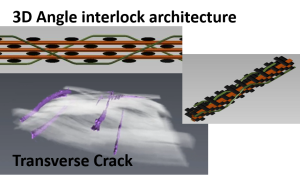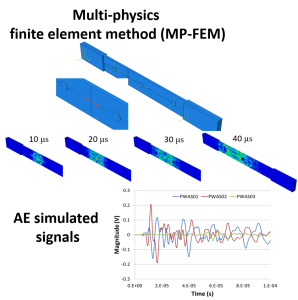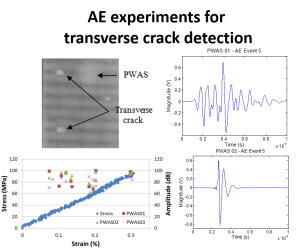Transverse Crack detection using Acoustic Emission of 3D Angle Interlock Glass Fibre Composites
 It is a big challenge to relate acoustic emission (AE) signal events to specific damage modes developed in composites under hygro-thermo-mechanical loading. This study provides further insight into the AE monitoring of a 3D angle interlock (AI) glass fibre composite and has revealed the complex nature of the relationship between the principal characteristics of recorded AE events on the one hand and the mechanical behaviour of the material on the other. Because the tested material here is transparent, t
It is a big challenge to relate acoustic emission (AE) signal events to specific damage modes developed in composites under hygro-thermo-mechanical loading. This study provides further insight into the AE monitoring of a 3D angle interlock (AI) glass fibre composite and has revealed the complex nature of the relationship between the principal characteristics of recorded AE events on the one hand and the mechanical behaviour of the material on the other. Because the tested material here is transparent, t he development of transverse cracks can be observed in-situ during the test using optical images on the specimen. Thiswork presents experimental and simulated results on the use of AE on 3D AI glass fibre composites for structural health monitoring (SHM) of transverse matrix cracks, during quasi-static tension of flat plates.
he development of transverse cracks can be observed in-situ during the test using optical images on the specimen. Thiswork presents experimental and simulated results on the use of AE on 3D AI glass fibre composites for structural health monitoring (SHM) of transverse matrix cracks, during quasi-static tension of flat plates.
The high frequency and the low frequency component correspond to the wave’s extensional mode S0 and to the flexural mode A0, respectively. This flexural mode has higher amplitude than the extensional mode. It seems that the transverse cracks generate more flexural motion than extensional motion. This presence of a flexural mode would indicate that the crack does not develop symmetrically about the m id-plane of the 3D AI laminate. The crack initiation for the loading in weft direction occurs in the range of applied strain 0.07…0.1% (Figure, showing the data for weft direction loading), a relatively very low level of strain. The amplitude for each AE events (i.e. transverse crack) is between 60 to 100 dB. The signals with lower amplitude were assimilated into noise.
id-plane of the 3D AI laminate. The crack initiation for the loading in weft direction occurs in the range of applied strain 0.07…0.1% (Figure, showing the data for weft direction loading), a relatively very low level of strain. The amplitude for each AE events (i.e. transverse crack) is between 60 to 100 dB. The signals with lower amplitude were assimilated into noise.
